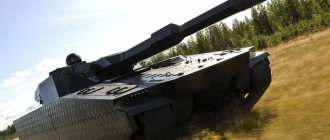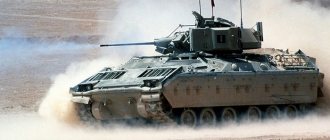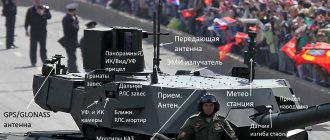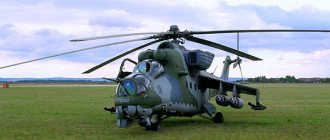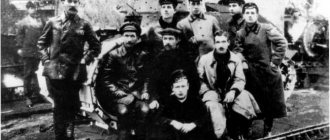The Kurganets-25 BMP was first shown to spectators at the victory parade on May 9, 2015. The armored personnel carrier became one of the newest pieces of military equipment presented to the general public that day. He immediately found an additional nickname among the Russian public - the younger brother of the Armata tank.
Indeed, some external elements and angular contours of the hull are similar to the model of a modern tank. But still, this is an independent development of the Kurgan Machine-Building Plant, which produced armored infantry vehicles of the USSR for many years.
History of creation
The new multi-purpose platform Kurganets-25 should become a worthy replacement for the BMP and MT-LB (multi-purpose tractor) currently in service. The plant's designers were tasked with creating new armored vehicles for transporting personnel and equipping infantry fighting vehicles with powerful weapons for the vehicle's direct participation in combat.
In addition, the new Kurganets-25 platform should become universal for creating modified models, such as:
- airborne combat vehicle (BMD);
- self-propelled artillery unit (SAU);
- BMP T-15 "Barberry";
- wheeled armored personnel carrier "Boomerang".
The prototype of the armored vehicle has a high profile, which significantly distinguishes the modern copy from similar Soviet equipment.
For the survivability of the infantry fighting vehicle, engineers decided to increase the ground clearance, which undoubtedly contributes to less damage to the vehicle in the event of a mine or explosive device.
Thanks to the hydraulic mechanism, the ground clearance has become adjustable with the ability to take the required height position. It is worth adding to everything that the bottom is made in the form of a double floor.
An enlarged compartment for infantrymen is another necessary requirement. Modern fighters of large build. In addition to all this, they are forced to carry bulky equipment: a protective helmet and goggles, body armor, personal communications equipment and several types of weapons.
This significantly distinguishes a modern warrior from a Soviet infantryman, who was armed with a machine gun, a sapper's shovel and a helmet. Soviet equipment was made just for average height and minimal equipment. Military doctrine has changed.
Now fighters need more space in their equipment and this requirement has been taken into account.
The Kurganets-25 BMP has separate seats, similar to armchairs.
In 2016, the Kurgan Machine-Building Plant demonstrated the following prototypes:
- BMP B-11 under the symbol “object-695”;
- BTR B-10 “object-963”;
- BREM (combat repair and maintenance vehicle).
The latest sample has entered testing, which can last from several months to several years. Such a long stage of testing is necessary to check all components and systems of a modern armored vehicle.
Project "Kurganets-25": known and unknown
Currently, the Russian armed forces have several types of infantry fighting vehicles, as well as other classes of equipment built on their basis. In the future the situation should change. Over the past few years, several defense enterprises have been working on a project for a unified tracked platform, on the basis of which it is planned to build infantry fighting vehicles, armored personnel carriers, command and staff vehicles and other equipment. All this will allow us to solve several problems at once, from modernizing the fleet of armed forces equipment to reducing the costs of its operation. The promising infantry fighting vehicle, which will have to replace existing vehicles, is built on the basis of the Kurganets-25 platform. The development of this project started in the middle of the decade, and by now the project has reached the stage of construction of pre-production armored vehicles. The first samples of promising combat vehicles were shown at the Victory Parade in May. According to available data, the Kurganets-25 family of equipment is currently undergoing various tests and may be put into service in the foreseeable future.
For objective reasons, the authors of the project and future operators cannot yet disclose most of the information about the promising technology. Therefore, the general public has to be content with small mentions of certain features of the project, as well as published fragmentary data or expert assessments. Due to the secrecy inherent in all new projects, detailed and accurate data about Kurganets-25 will only appear in the future. However, the information currently available allows us to draw a rough picture. Let's try to collect the currently available information about the unified platform and machines based on it.
BMP "Kurganets-25". Photo Vitalykuzmin.net
A few years ago it became known that Kurganmashzavod OJSC was appointed as the developer of the promising platform, which, among other things, affected the name of the project. Design work continued over the next few years, and from time to time there were reports of the planned “premiere” of new technology. So, initially, a prototype BMP based on the Kurganets-25 platform was supposed to be built in 2012. However, as a result, the first closed display of the prototype took place only in the fall of next year at the Russia Arms Expo 2013 exhibition. Around the same time, information appeared about the planned display of new equipment at the parade on May 9.
The goal of the project was to create a tracked vehicle suitable for use as a base for various types of armored vehicles. First of all, it was necessary to create an infantry fighting vehicle and a tracked armored personnel carrier. In addition, it was planned to develop a repair and recovery vehicle, anti-aircraft and anti-tank missile systems, etc. The possibility of developing a self-propelled artillery mount was also mentioned.
At the beginning of 2013, a shot appeared in the media from the workshop of the Kurganmashzavod, where the body of one of the prototypes of a promising armored vehicle was being assembled. In addition, various drawings and diagrams appeared on specialized resources with enviable regularity, the authors of which tried to predict the appearance of the new technology. At the same time, the actual appearance of the BMP and other vehicles based on the Kurganets-25 platform remained a secret until the spring of 2015. Only after the first rehearsals of the Victory Parade were specialists and the general public able to see promising combat vehicles for the first time, and not drawings that were not directly related to this technology.
BTR "Kurganets-25". Photo Vitalykuzmin.net
It is noteworthy that the new equipment that participated in the rehearsal did not immediately receive the entire set of additional equipment, thanks to which everyone was able to see some of its interesting features. For example, during the first rehearsals, infantry fighting vehicles and armored personnel carriers of the Kurganets-25 family were left without additional side units, which made it possible to examine their chassis. However, there was a “fly in the ointment”: the combat modules of the vehicles were covered with tarpaulin covers.
By now, some basic design features of the platform and the technology based on it have become known. To meet the new requirements of the customer represented by the Ministry of Defense, as well as to ensure maximum unification of various types of equipment, some new ideas and solutions are used in the design of the Kurganets-25 platform. In addition, it was decided to abandon a number of previous developments used in old armored vehicle projects.
The general layout of the Kurganets-25 platform is made taking into account the latest global trends in the development of armored vehicles. Thus, the engine-transmission compartment is located in the front part of the armored hull, and the transmission units are located directly behind the frontal parts of the vehicle, and the engine is located behind them on the starboard side. To the left of the engine there is a relatively narrow control compartment with a driver's workplace. Directly behind the engine are the workplaces of other crew members. For example, in the version of an infantry fighting vehicle, the commander and gunner-operator are located there. The aft part of the hull is given over to the installation of the necessary equipment or deployment of troops.
The first known image of the Kurganets-25 vehicle. Still from a report by the Zvezda TV channel / Gurkhan.blogspot.ru
According to the Zvezda TV channel, which recently showed an episode of the Military Acceptance program about the Kurganets-25 infantry fighting vehicle, the platform can be equipped with two types of engines, Chelyabinsk and Yaroslavl production. At the time of filming the television program, the customer had not yet made the final choice of the power plant. However, it was noted that both engines fully comply with the requirements and provide the necessary performance.
The engine, regardless of its type, is connected to an automatic transmission. This unit has six forward gears and three reverse gears. It is claimed that in third reverse gear the BMP is capable of reaching speeds of up to 20 km/h. The engine torque is transmitted to the front drive wheels with lantern gearing.
Quite a long time ago, all those interested were able to consider all the main features of the Kurganets-25 chassis. The platform has seven road wheels on each side. According to some sources, an adjustable hydropneumatic suspension was used. If necessary, the driver can change the vehicle's ground clearance from 100 mm to 500 mm. This feature of the chassis makes it possible to reduce the dimensions of the vehicle both during transportation and when hiding in a trench.
Gearbox of the Kurganets-2 platform. Still from TV station “Military Acceptance”, TV channel “Zvezda”
The design of the Kurganets-25 platform involves the use of a hull with bulletproof armor. The hull has a characteristic frontal design with a strongly sloping top sheet and an almost vertical bottom sheet. The sides and stern of the hull are positioned strictly vertically. The upper frontal part has hatches for access to the engine and transmission compartment. The armor protection parameters have not yet been announced. What is known is that the chassis body provides protection against bullets of 7.62 and 12.7 mm caliber. The type of bullets and cartridges was not named. The Kurganets-25 project initially provides for the installation of various additional protection systems, including mounted armor, dynamic protection, etc. All this allows you to significantly increase the level of protection in accordance with the intended role of the machine.
According to various estimates, armored vehicles of the Kurganets-25 family, having a relatively powerful engine, will be able to reach speeds of up to 70-80 km/h on the highway. High mobility on rough terrain must also be ensured. At the customer's request, the platform received water-jet propulsion for crossing water obstacles by swimming. Using these units, an infantry fighting vehicle or other equipment of the family will be able to move at speeds of up to 10 km/h.
“Declassified” gear lever. Still from TV station “Military Acceptance”, TV channel “Zvezda”
The promising machine is controlled using several main devices. The driver has at his disposal a steering wheel, a gear lever, a pair of pedals and a set of control instruments. Unfortunately, the interior of the control department is still a secret and the corresponding photographs or video materials have not yet been published. At the moment, only the appearance of the gear lever is known - journalists from the Zvezda channel were allowed to film this detail.
The crew has a set of periscopic viewing devices. In addition, the project provides additional equipment that improves visibility. Along the perimeter of the combat vehicle’s body there are several sets of television cameras, the signal from which is transmitted to monitors, the driver, the commander, etc. An additional monitor with the ability to monitor the situation is installed even in the airborne squad of the infantry fighting vehicle.
At the moment, we can confidently talk about the start of production of only an infantry fighting vehicle and an armored personnel carrier based on a common chassis. Other equipment of the family is being developed, but precise data on the progress of work and plans for its construction is not yet available. For example, in one of the already mentioned episodes of the “Military Acceptance” program, the Zvezda TV channel showed the process of assembling an armored hull for a repair and recovery vehicle. In addition, presumably another vehicle of this type, which is in the late stages of assembly, was captured in the frame. However, precise information about the Kurganets-25 family ARV project is not yet available. Apparently, assembly of a pilot batch has already begun, but this is just an assumption.
One of the television camera blocks on the body. Still from TV station “Military Acceptance”, TV channel “Zvezda”
The Kurganets-25 armored personnel carrier and infantry fighting vehicle receive much more attention than other vehicles in the family. In addition, the developer and customer, when talking about the new platform, first of all remember this technology. Therefore, the available volume of open data on infantry fighting vehicles and armored personnel carriers is much greater than in the case of other equipment.
A characteristic feature of the infantry fighting vehicles and armored personnel carriers participating in the parade on Red Square were large onboard armor modules. According to the latest data, these units perform a number of important functions aimed at increasing protection and mobility characteristics. It is known that on-board modules are equipped with dynamic protection units and some other armor, which makes it possible to supplement the hull’s own armor. In addition, the modules act as floats when moving through water. Due to their own buoyancy, the modules improve the performance of the entire machine. At the same time, however, “Kurganets-25” can float without installing additional equipment.
In the case of a promising infantry fighting vehicle, additional protection is provided by an active protection complex, individual elements of which are installed on the roof of the hull and on the combat module. An electronic system designed to neutralize anti-tank mines with a magnetic fuse is also provided.
The result of shelling the armor. Bullets of 7.62 mm and 12.7 mm caliber remained inside the plate. Still from TV station “Military Acceptance”, TV channel “Zvezda”
An infantry fighting vehicle based on the new platform has a crew of three and is capable of carrying up to eight paratroopers. The crew is located in the front part of the habitable volume of the hull, and the troop compartment is located in the stern. It is known that fighters with weapons should have their backs to the sides. The appearance of the seats and their layout are still classified. Thus, in a sample of a combat vehicle filmed by the Zvezda TV channel, all the equipment of the airborne squad was covered with a tarpaulin and shields with unambiguous inscriptions “secret”.
The crew of a combat vehicle has two hatches in the roof of the hull: the driver has his own hatch, and the commander and gunner-operator must use a common one. A large ramp is provided in the stern plate of the hull for landing and disembarking troops. When opened, it lowers down using its own drives and facilitates dismounting. In addition, the ramp has a door that can be used if the drives fail. For self-defense, the door has an embrasure for the landing party's personal weapons.
It is known that the customer, represented by the Ministry of Defense, included in the requirements for a promising infantry fighting vehicle the requirement for maximum autonomy, as well as protection of the crew and troops from external influences. To do this, the car receives an air conditioning system with air purification facilities. Pipelines are provided to supply purified air to the crew and landing areas. Additional comfort and the possibility of long-term operations away from the bases are provided with the help of sanitary equipment mounted on the stern door.
Combat module "Epoch". Photo Nevskii-bastion.ru
Promising infantry fighting vehicles and armored personnel carriers differ in their combat module. In the case of an infantry fighting vehicle, it is proposed to use the Epoch product, also known as the Boomerang-BM. This combat module is a turret with cannon and missile weapons installed on the roof of the base vehicle. An important feature of the Epoch module is the placement of all units outside the habitable volume of the hull.
The BMP with the Epoch module is armed with a 2A42 automatic cannon of 30 mm caliber with selective power, a coaxial PKTM machine gun and a Kornet-EM missile system. The gun's ammunition capacity is 500 rounds of two types, the machine gun's ammunition boxes hold 2,000 rounds, and the onboard launchers accommodate four containers with guided missiles. The module contains blocks of optical-electronic equipment for observing and searching for targets, as well as fire control.
Having other tasks, the Kurganets-25 armored personnel carrier is equipped with a different combat module. In the case of an armored personnel carrier, a module with machine gun armament and some additional equipment is used. Such differences in weapons are primarily associated with the difference in the intended tasks of the two classes of equipment.
Machine gun combat module of an armored personnel carrier. Photo Vitalykuzmin.net
Both combat modules of advanced technology are equipped with remote control systems. Controls for all weapon systems are located at the workplaces of commanders and gunner-operators. Thus, the use of unmanned combat modules made it possible not only to provide the required firepower, but also to optimize the layout of the habitable volume without the need to place crew members directly under the combat module.
Unfortunately, even the most general characteristics of promising technology still remain unknown. The military has not yet announced the actual maximum speed or range, not to mention the parameters of various weapons. This approach is quite understandable, since the project has not yet been brought to its logical conclusion and most of its details are still not worth publishing in order to avoid various negative consequences.
Several promising vehicles based on the Kurganets-25 platform took part in the Victory Parade. Nine armored personnel carriers and the same number of new types of infantry fighting vehicles passed through Red Square. According to some reports, the construction of the first batch of equipment involved in the parade was completed in the first months of 2015. Subsequently, the assembly of equipment for testing continued and, apparently, is still going on.
During the recent Russia Arms Expo 2015 exhibition, Kurganmashzavod management spoke about their plans for the future, touching on the topic of a promising unified tracked platform. The executive director of the enterprise, Alexander Klyuzhev, said that early next year the next delivery of Kurganets-25 vehicles to the military will take place. The Ministry of Defense will receive both infantry fighting vehicles and new types of armored personnel carriers. The number of equipment in this batch was not specified.
In the workshop of Kurganmashzavod. in the background is the Kurganets-25 armored personnel carrier, in front, presumably, is a promising ARV. Still from TV station “Military Acceptance”, TV channel “Zvezda”
A. Klyuzhev also recalled that several types of military equipment will be developed on the basis of the universal chassis. In the near future - the creation of an armored repair and recovery vehicle. It is noteworthy that the assembly of the body of such a machine was demonstrated in the “Military Acceptance” program. This means that the company is already implementing the next project of the family.
During this year, representatives of industry and the military department spoke about the approximate timing of putting new equipment into service. During 2015-16, it is planned to complete all the necessary tests of new infantry fighting vehicles and armored personnel carriers, after which they can be put into service and put into series. Thus, serial production of promising armored vehicles will start approximately in 2017-18. For obvious reasons, these are still only preliminary plans, and the actual date for the start of mass production and operation may shift noticeably.
Until a certain time, industry and the military were in no hurry to reveal the secrets of the promising Kurganets-25 project, which is why the public had to rely only on fragmentary information and assessments of varying degrees of credibility. In the last few months, the situation has changed dramatically, thanks to which all those interested have had the opportunity to learn some details of the latest projects. Let's hope that the existing tradition will continue, and the military and industry will continue to delight us with new messages about the progress of the project and various interesting technical details.
Based on materials from the sites: https://ria.ru/ https://tass.ru/ https://interfax.ru/ https://tvzvezda.ru/ https://nevskii-bastion.ru/ https:// army-guide.com/ https://bmpd.livejournal.com/
Design
The body of the armored vehicle is divided into several compartments. The forward right compartment houses one of two engine options: the opposed “2V-06” or the in-line “YAMZ-780” with a pair of turbochargers. Also in this compartment are transmission units. The front placement of the power plant made it possible to better arrange the interior of the infantry fighting vehicle.
The compartment for transporting personnel can accommodate eight soldiers. Disembarkation from armored vehicles occurs through the rear ramp. It is additionally equipped with a door that serves as an emergency exit if the ramp tilting system is damaged.
The left compartment is the driver's seat with steering elements. Gas and brake as standard controller pedals. The directional control is coordinated by a steering-type rudder, similar to the BMP-3. The gear selection buttons are located on the steering wheel, reminiscent of the steering wheel of a sports car.
Kurganets-25 has a crew of three people.
A passive armor system is used to protect soldiers. The tower is equipped with an active protection module that destroys incoming projectiles.
The ammunition and weapons of the infantry fighting vehicle are located in an individual compartment, which increases the protection of personnel from unauthorized detonation of shells. High cross-country ability is achieved using a hydropneumatic system that regulates ground clearance.
Containers that serve as floats can be installed on both parts of the conveyor. They cover the side parts from the tower level to the axial centers of the drive wheels.
If necessary, this attachment can be dismantled in the shortest possible time. The purpose of hanging containers is to add stability to the conveyor on the water surface. In addition, linings (floats) serve as passive protection for personnel and crew members of infantry fighting vehicles from being hit by shells.
Movement on water is carried out using a water-jet engine, which significantly distinguishes the new technology from its predecessors, which moved on water using caterpillar tracks.
Exploitation
Almost nothing is known about the experience of practical use of the new infantry fighting vehicle. Individual copies were sent to the troops for preliminary testing back in 2015-16. Based on the results of this inspection, it was said that the military did not like the too high profile of the Kurganets. However, the height of the car has not changed since then.
In the spring of 2022, a number of news agencies reported that Kurganets 25 had been spotted in Syria. However, no details were provided.
The Ministry of Defense intends to begin large-scale operation of this infantry fighting vehicle before the end of 2022, but this will only become possible if Kurganmashzavod does not miss the deadline for completing the necessary work.
Armament
Depending on the version, the installation of the necessary weapons is selected for the infantry fighting vehicle. For example, the self-propelled gun is equipped with a 125 mm anti-tank gun.
The Kurganets-25 and Boomerang infantry fighting vehicles are equipped with the Bumerang-BM unmanned radio-controlled combat system.
It consists of a 30 mm automatic cannon with selective supply of projectiles from two boxes, a 7.62 mm machine gun, as well as a Kornet anti-tank complex.
control. The tower is uninhabited. The commander and gunner have the ability to control the combat arsenal using remote control panels. In addition, the programmed complex has the ability to independently take control of a target and, if necessary, fire at it to kill.
For increased all-round visibility, the armored vehicle is equipped with eight video cameras, the images of which are displayed on the screen.
History of the development of the Kurganets infantry fighting vehicle
The Soviet army, which disappeared along with the USSR, left behind a rich and varied armored “legacy”. There were three types of main battle tanks alone. Nothing like this has been observed in any other country in the world. In addition, BMP-1, BMP-2, BMP-3, BMD and many different auxiliary vehicles created on their basis were simultaneously operated. The need for unification and transition to some kind of single platform was obvious even then, but in the conditions of the collapse of the economy, this was impossible to do.
BMP-2, destroyed during the “New Year’s assault” on Grozny on the night of January 1, 1995
An additional incentive for the development of light armored vehicles was the military operations in Chechnya, which were accompanied by heavy losses and showed how vulnerable Russian armored personnel carriers and infantry fighting vehicles are. Already in 1995, the Main Armored Directorate (GABTU) prepared technical specifications for the development of several types of armored combat vehicles on a single platform, which was then considered the promising T-95 tank. This project, which received the code name “One-Volume Book,” lasted until the beginning of the 2000s, but apparently the matter did not go beyond sketches and drawings.
In 2004, information was leaked to the press that at the Kurganmashzavod enterprise, where the BMP-2 and BMP-3 are produced, design work was underway, the purpose of which was to provide the army with new infantry fighting vehicles and tracked armored personnel carriers, created on a single unified base. Even drawings were published depicting the future Kurganets 25 infantry fighting vehicle. At the same time, there was no reliable data for a long time, which was explained by the increased level of secrecy. As a result, doubts arose about the very existence of the new car, which were finally dispelled only shortly before its official presentation.
The first official photograph of the Kurganets-25 infantry fighting vehicle. Distributed by the Ministry of Defense shortly before the display at the parade
Having “shone” at the parade, “Kurganets” nevertheless has not yet entered the army, despite its successful testing in Syria in real combat conditions. One of the reasons for such a long period of “fine-tuning” the BMP is the deplorable state of the Kurganmashzavod. The only Russian enterprise of its kind has been teetering on the brink of bankruptcy for several years now. What adds piquancy to this situation is the fact that Albert Bakov, who led Kurganmashzavod until 2022, was himself declared uncreditworthy - his personal debts reached almost 80 million rubles. In addition, the enterprise is formally owned by Dutch investors, which, to put it mildly, is very strange for a company that is part of the defense complex.
In July 2022, the Russian Ministry of Defense entered into a contract with Kurganmashzavod for the supply of the first production batch of the Kurganets infantry fighting vehicle. The validity period of this agreement is 2022. It is difficult to say what will come of this, given that the company failed an earlier contract for the modernization of the BMP-3, despite a personal order from the president of the country.
Specifications
The German Puma (Schützenpanzer Puma) is considered one of the best infantry fighting vehicles in the world. The weight of the German infantry fighting vehicle is more than 40 tons, which significantly exceeds the weight of the Kurganets-25, which weighs 25 tons.
Like all USSR infantry fighting vehicles, the modern platform can swim, but the German Puma is not endowed with this quality.
The protective armor complex of the domestic vehicle is capable of protecting it from a direct hit from an RPG-7. German manufacturers claim that their infantry fighting vehicles are equipped with additional protection against similar hits from anti-tank grenade launchers, but this is far from the case. German technology does not have dynamic protection.
If we compare combat modules, then again the advantage remains with Kurganets-25. Since in addition to 30 mm guns on both vehicles, domestic equipment is additionally equipped with the Kornet guided missile system.
It is worth noting that German technology does not have guided weapon systems similar to the Boomerang-BM. The table shows the main characteristics of competing infantry fighting vehicles.
| Name | BMP Kurganets-25 | BMP "Puma" |
| Manufacturer | OJSC "Kurganmashzavod" | KMW/RLS |
| Total weight, kg | 25 000 | 25 000 |
| Crew, people | 3 | 3 |
| Personnel capacity, persons | 8 | 7 |
| Power point | Uraltrak 2V-06/ YaMZ-780 | 10V 892 HPD MTU |
| Power plant power, l/s | 550/750 | 800 |
| Average speed, km/h | 60 | 60 |
| Suspension type | Torsion bar | — |
| Armament | Complex "Boomerang-BM" | automatic cannon 30-mm "Rheinmetall" MK 30-2/AVM grenade launcher for 6 grenades, mounted on the rear of the vehicle hull |
During testing
The Ministry of Defense and military-industrial complex enterprises have agreed on a schedule for testing infantry fighting vehicles and armored personnel carriers from the Kurganets-25 family, sources in the military-industrial complex said. Judging by the work schedule, which Izvestia reviewed, preliminary tests of combat vehicles will take place from May to October 2022. And state tests will begin in November and, according to plans, should be completed in 12 months. It is noteworthy that testing of individual components and assemblies of armored vehicles is currently already underway.
According to Izvestia’s sources, it is possible that after the completion of state tests of the Kurganets, additional time will be allocated to correct the identified shortcomings.
The agreement to complete development work on the medium tracked platform of Kurganmashzavod was signed in December last year. And already in February, Russian Minister of Industry and Trade Denis Manturov announced that the final delivery dates for the Kurgan tanks would be determined by the Ministry of Defense based on the results of state tests. According to him, they are tentatively scheduled for completion in 2022.
“State tests are a rather lengthy process; you don’t just have to drive along the highway and shoot, but carry out a whole range of events,” military expert Viktor Murakhovsky told Izvestia. — It includes, for example, life tests, that is, the engine must work the required number of engine hours. The chassis must cover a given number of kilometers without replacing caterpillar tracks, and on different types of soil. The equipment must be tested in high mountains, in conditions of extreme heat and severe frost. The possibility of maintenance and repair in the field is also checked. Both real terms and resource costs for maintenance during operation will be recorded.
Changing wheels: new armored vehicles will change the face of the Airborne Forces
The first promising armored vehicles "Typhoon-VDV" will be received by reconnaissance and special forces paratroopers
According to the expert, in addition to testing the chassis, weapons are being tested. It is necessary to maintain a given resource in terms of its survivability and maintaining the specified parameters. Absolutely everything will be checked, including the optical-electronic system and communications. Therefore, a year is still a relatively short period of time for a full cycle of state tests.
